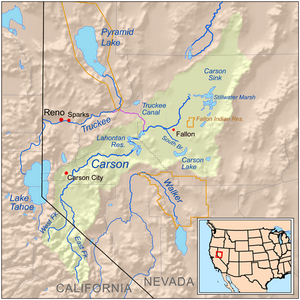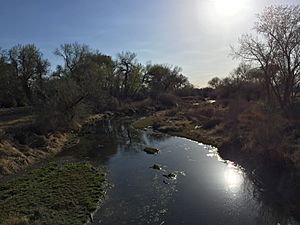Carson River facts for kids
Quick facts for kids Carson River |
|
|---|---|

Carson River at Dayton, Nevada
|
|

Carson River Basin
|
|
| Country | United States |
| State | Nevada |
| Region | central Lahontan region |
| Physical characteristics | |
| Main source | West Fork Carson River Carson Pass, Alpine County, CA |
| 2nd source | East Fork Carson River Sonora Peak, California |
| Length | 131 mi (211 km) |
| Basin features | |
| Basin size | 3,930 sq mi (10,200 km2) |
The Carson River is a river in Nevada, United States. It flows into the Carson Sink, which is a basin where water collects and doesn't flow out to the ocean. The main part of the river is about 131 miles (211 km) long. If you add its East Fork, it's about 205 miles (330 km) long.
The river flows through five counties in California and Nevada. It's named after Kit Carson, a famous guide who helped John C. Frémont explore the West in 1844. The Carson River is important for its history, wildlife, and for outdoor activities.
Contents
River History: A Journey Through Time
Who Lived by the River First?
Long ago, about 12,000 years ago, the first people lived near the Carson River. These were the prehistoric Martis people. Later, the Northern Paiute people lived near the lower part of the river. The Washoe people lived in the upper parts. Both tribes used the river for fishing, hunting, and gathering plants. It was a very important source of water in the dry Nevada desert.
Early European Settlements and Gold Rush
The first European towns in Nevada were built along the Carson River in 1851. These were Mormon Station (now Genoa) and Gold Canyon (now Dayton).
In the 1850s and 1860s, the river was part of the Carson Trail. This trail helped people get to the gold fields in California. The Pony Express also used this route. Gold was found along the river in 1860. The Virginia and Truckee Railroad was built in 1868 to carry ore from mines.
The Comstock Lode in 1859 brought a huge silver rush to Virginia City, Nevada. This mining had a big impact on the river. It caused forests to be cut down and left behind mining waste. This led to high levels of mercury in the river.
Modern River Management
In the early 1900s, the Newlands Reclamation Act helped bring water for farming. The Lahontan Dam was finished in 1914 as part of this project. It helped control water for farms.
In 1989, the East Fork Carson River was named a "Wild and Scenic River" in California. This means it is protected and cannot be dammed.
Carson River's Path: Where Does it Flow?
The Carson River watershed covers about 3,966 square miles (10,270 km²). It has two main branches that start in the Sierra Nevada mountains.
- The East Fork is about 74 miles (119 km) long. It starts high up on Sonora Peak in California.
- The West Fork is about 40 miles (64 km) long. It starts near Carson Pass.
These two forks join together near Minden, Nevada. The river then flows north towards Carson City, Nevada. After that, it goes northeast through Lyon County, past Dayton.
The river then reaches the Lahontan Dam in Churchill County. Water from the Truckee River also joins here and is stored in Lake Lahontan. Downstream from the dam, much of the water is used to water farms near Fallon. The rest flows into the Carson Sink.
Clear Creek is the only stream that flows into the main Carson River all year long. It starts in the mountains west of Carson City.
Carson River Mercury Superfund Site: What Happened?
The Carson River basin was named a "National Priority Listed" (NPL) site in 1990. This happened because of mercury pollution from old mining activities. It's the only NPL site in Nevada. The state and the U.S. Environmental Protection Agency (EPA) work together to manage it.
Why is There Mercury?
During the Comstock Lode mining boom (1850s-1890s), millions of pounds of mercury were used. Miners used mercury to separate gold and silver from the ore. It's estimated that about 14 million pounds of mercury were lost into the environment during this process. Other metals like arsenic and lead were also released.
How Does Mercury Affect the River?
Mercury can be harmful to living things. In the river, bacteria can change mercury into a form called methylmercury. This type of mercury can build up in fish and other wildlife. When animals eat these fish, the mercury can move up the food chain. This is called bioaccumulation and biomagnification.
Scientists have found high levels of mercury in some fish and birds in the area. While studies haven't shown direct harm to people living nearby, eating too much fish or waterfowl from the affected areas is not recommended. This is especially true for children, whose bodies are still developing.
What is Being Done?
Since complete cleanup of the entire river system is very difficult and expensive, a plan called the Long Term Sampling and Response Plan (LTSRP) was created. This plan helps manage the pollution for the future. It guides how land can be developed to make sure people are safe from contaminated soils. Soil testing is often required before building homes or businesses.
Mercury Amalgamation: How Mining Caused Pollution
The mercury in the Carson River mainly came from mining waste during the Comstock Lode. Miners in the 1850s used a method called mercury amalgamation to get silver and gold.
The Amalgamation Process
This process involved crushing the ore (rock with metal) and mixing it with mercury. The mercury would stick to the gold or silver, forming a mixture called an amalgam. Then, the amalgam was heated to make the mercury turn into a vapor, leaving the pure gold or silver behind.
A new method called "Washoe hot-pan" amalgamation was developed in 1861. This method used a cast iron pan with the ore mixture, mercury, sulfuric acid, and other materials.
How Mercury Was Lost
Mercury was lost in many ways:
- Transportation: Mercury was carried in leaky bags, pails, and barrels.
- Equipment: Mining equipment was not good at containing the waste.
- Processing: A lot of mercury was lost during the amalgamation process itself. It was hard to recover all the vaporized mercury.
It's estimated that as much as 0.7–1 kg (1.5–2.2 lbs) of mercury was lost for every tonne of ore processed.
Hydraulic mining was also used. This method uses powerful jets of water to wash away soil and rock. Mercury was used in the sluices (channels) to catch gold and silver. As water flowed, mercury could leak out and pollute the surrounding area.
River Life: Animals and Plants

The Carson River is home to many different animals.
Birds
In the lower parts of the river, the Stillwater National Wildlife Refuge is a home for many birds. You can see large groups of white-faced ibis and American white pelicans. In winter, tundra swans, ducks, and geese visit. Smaller birds like tree swallows and house wrens also live here. Studies have shown that some of these birds have mercury in their bodies and eggs.
Fish
The upper Carson River is a great place for fishing. It has the threatened Lahontan cutthroat trout. You can also find non-native rainbow trout and brown trout. There's a special, pure group of Lahontan cutthroat trout in the East Fork. The only known population of Paiute cutthroat trout lives in Silver King Creek, which flows into the East Fork.
Beavers
North American beavers were brought back to the Carson River around 1940 and have done very well. People living in the area long ago, like the Washoe people, had words for beaver. Historical records show that beavers were common in the area. Trappers like Peter Skene Ogden and John "Grizzly" Adams caught many beavers in the Carson River region in the early 1800s.
Fun on the Carson River: Recreation
The Carson River offers many ways to enjoy the outdoors.
Fishing
The river is known for its excellent trout fishing. Anglers can catch Lahontan Cutthroat, Rainbow, and Brown Trout in the upper river. Further downstream, the water gets warmer, and you can find different kinds of fish.
Other Activities
- Hiking: You can go hiking in the Carson-Iceberg Wilderness along the upper river.
- Boating: Kayakers and river rafters enjoy the gentle rapids and beautiful scenery of the lower river. There are even hot springs along the riverbanks!
- Other Sports: The area is also popular for mountain biking, off-roading, hunting, and horse-back riding.
While there are many places to access the river, some areas have limited public access due to development.
See also
 In Spanish: Río Carson para niños
In Spanish: Río Carson para niños

